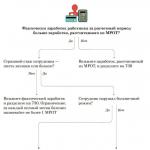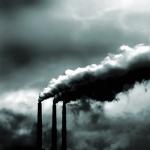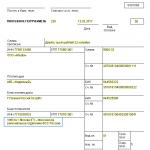What is included in the concept of an industrial facility. Industry: what is, objects, products, importance in the economy
In order to characterize the concept of an industrial facility, we must first consider the concept of industrial activity, as an environment and form of existence of industrial facilities.
Industrial activity is a type of entrepreneurial activity aimed at the development and manufacture of material goods in terms of the production of tools and objects of labor, including the extraction and processing of minerals and natural resources, the production of construction parts and materials, the processing of agricultural products, the production of energy and energy carriers, repair and recovery work, as well as activities for the processing (disposal) or destruction of solid, liquid and gaseous waste arising in the course of production processes.
Consequently, being elements of industrial activity, an industrial facility is a property complex used by a subject of industrial activity to carry out industrial activity.
Another option for defining an industrial facility is as follows. Industrial facility - an enterprise, workshop, site, unit and other production units used to carry out industrial activities.
A set of industrial facilities, united according to certain criteria, can form new types of industrial facilities:
- 1. Industrial hub.
- 2. Industrial park.
An industrial hub is a group of enterprises located on the same territory, with common communications, engineering structures, auxiliary industries and farms, and, under appropriate conditions, with the cooperation of the main industries.
Industrial parks - a complex of real estate objects managed by a single operator of the park (administrative, production, warehouse and other premises supporting the operation of an industrial park) with an area of \u200b\u200bat least 100,000 sq. m and infrastructures that allow compact placement and provide conditions for the efficient operation of small and medium-sized enterprises.
Since the purpose of our course work is to solve a set of theoretical problems related to the theoretical foundations of the formation of industrial facilities, their legal regulation, planning and design, as well as overcoming the urgent problems of reconstruction and development of industrial zones in cities, we will consider the concept of an industrial facility from the point view of architecture and urban planning.
According to clause 1.7. SNiP 2.07.01-89 *. “Building codes and regulations for urban planning. Planning and development of urban and rural settlements ", taking into account the functional use, the territory of the city is subdivided into:
- 1. Residential;
- 2. Production
- 3. Landscape and recreational.
Within the indicated territories, zones of various functional purposes are distinguished:
- 1. Residential development.
- 2. Community centers.
- 3. Industrial areas.
- 4. Scientific and scientific-production zones
- 5. Utility and storage areas.
- 6. Zones. External transport
- 7. Recreation areas.
- 8. Resort zones (in cities and towns with medicinal resources), protected landscapes.
The production area is intended for the location of industrial enterprises and related facilities, complexes of scientific institutions with their experimental production facilities, communal storage facilities, external transport facilities, and out-of-town and suburban routes.
Since the production area is a set of production facilities, according to SNiP 2.07.01-89 *. “Building codes and regulations for urban planning. Planning and development of urban and rural settlements "industrial facilities can include:
- 1. Directly industrial facilities.
- 2. Complexes of scientific institutions connected with industrial facilities with their experimental production facilities.
Also, depending on the type of activity, industrial facilities can include communal storage facilities and external transport facilities.
Industrial facilities in the course of planning procedures in urban planning are planned, designed and located in the industrial zones of the city. Thus, the industrial zone of the city can consist of industrial enterprises and industrial centers.
According to the requirements of urban planning regulations, industrial facilities from among industrial enterprises and units that make up the industrial zone of the city should be located on the territory provided for by the scheme or project of the district planning, the general plan of the city or other settlement, the project for the planning of the industrial area, which is regulated by the provisions of SNiP II -89-80 - Building codes and general plans of industrial enterprises. Industrial enterprises, as a rule, should be located on the territory of industrial zones (districts) as part of groups of enterprises (industrial hubs) with common auxiliary production or infrastructure facilities, and in rural settlements as part of industrial zones.
At the same time, when planning the placement of industrial zones, it is necessary to ensure their rational transport interconnection with residential areas with minimal time spent on labor movements. On the other hand, the territories of industrial hubs should not, as a rule, be divided into separate sections by railways or highways of the general network.
The size and degree of intensity of use of the territory of industrial zones should be taken depending on the conditions of their placement in the structure of the city and the urban planning value of various sections of its territory, providing for multi-storey construction and the use of underground space.
The functional and planning organization of industrial zones should, as a rule, be provided in the form of panels and blocks of main and auxiliary industries, taking into account the industry characteristics of enterprises, sanitary and hygienic and fire safety requirements for their location, cargo turnover and types of transport, as well as the sequence of construction. In the course of design work on the industrial zone, it is necessary to form an interconnected system of services for workers at enterprises and the population of residential areas adjacent to the industrial zone.
An industrial facility is an enterprise, site, workshop, unit and other production units that are used to carry out industrial activities. An industrial facility is the basis of any industrial infrastructure, therefore, when designing it, it is necessary to take into account all technological features. At all stages of design, it is necessary to pay attention to all the elements required to ensure optimal conditions for future technological processes. The developed project documentation must strictly correspond to the purpose of the production.
Features of industrial design
Design of industrial facilities can be carried out in one or two stages. One-stage design is carried out for technically simple objects, the construction of which is planned to be carried out according to standard or reusable economical projects. Design in two stages involves the development of a technical project with a consolidated estimate and financial calculation, after its approval, working drawings are developed.
Industrial design is carried out by a team of different specialists. When designing industrial buildings and structures, existing norms and standards are used:
- SNiP (building codes and regulations);
- TP (technical rules);
- СН (sanitary standards);
- GOSTs.
An integral part of the design of industrial facilities is a thorough analysis of the future impact of the industrial facility on the environment.
Design stages
The main stages in the design of industrial buildings are:
- Planning goals... At this stage, a feasibility study or feasibility study is carried out, which should establish the economic and technical feasibility and economic need for the construction or reconstruction of the enterprise. At this stage, the following is also carried out: selection of a construction site, allotment of a land plot, preparation and approval of a design assignment.
- Design and survey works. This is the stage of development of design estimates based on the decisions made in the design assignment.
- Draft design. At this stage, the ideal design is carried out, then the configuration of the real solution by bringing the ideal sketch in accordance with the real environmental conditions based on the specifics of logistics, etc.
- Detailed design involves the addition and detailing of preliminary sketches to be implemented and preparation of the project for implementation.
- Development of an executive project - this is design taking into account all the necessary measures for the successful implementation of the project.
- The implementation of the project includes architectural supervision and control over the progress of the project and the commissioning of the facility.
"Project Group YUG" - architectural design of industrial facilities
Industrial design is a very laborious and responsible process, the successful completion of which depends on the professionalism of the specialists working on the project and perfect coordination with the customer. An unprofessional design of an industrial facility cannot ensure the safe and reliable operation of future production. Our specialists have vast experience in industrial design, so we can carry out a full range of design and engineering work at a high professional level, taking into account all technical standards, the purpose of the object and the wishes of the customer.
Industrial facility - a property complex used by a subject of industrial activity for its implementation
Source: LAW of the city of Moscow dated June 16, 1999 No. 21
"ON INDUSTRIAL ACTIVITIES IN THE CITY OF MOSCOW"
Industrial facility - an enterprise, workshop, site, unit and other production units used to carry out industrial activities
Source: "REQUIREMENTS FOR THE ASSESSMENT OF THE SAFETY OF OPERATION OF INDUSTRIAL BUILDINGS AND STRUCTURES OF SUPERVISED INDUSTRIAL PRODUCTIONS AND FACILITIES (SURVEY OF CONSTRUCTION CONSTRUCTIONS BY SPECIALTIES)"
(approved by AOZT "TSNIIPROEKTSTALKONSTRUKTSIYA" 11.12.1997)
References to the definition of "Industrial facility"
Dear site users. On this page you will find the definition of the term "Industrial facility". The information received will help you understand what Baggage is. If, in your opinion, the definition of the term "Industrial object" is erroneous or does not have sufficient completeness, we recommend that you suggest your own version of this word.
For your convenience, we will optimize this page not only for the correct query "Industrial facility", but also for the erroneous query "ghjvsiktyysq j,] trn". Such errors sometimes occur when users forget to change the keyboard layout when they enter a word into the search bar.
Manufacturing facilities represent a large group of enterprises that are united by the function of manufacturing products or providing services. Typically, such objects include factories and plants that produce material values \u200b\u200b- objects, things, raw materials, etc. But also trade enterprises can be included in this category. At the same time, production facilities can have many differences that relate to the management system, the technological organization of activities, the form of economic support, etc.
Manufacturing facility concept
The objects of production activity can be considered from different points of view - from economic, from functional, from administrative and technological. Therefore, it is customary to define them as a complex system, which is a complex of structures for different purposes. The primary purpose is to manufacture products at the facilities formed by the technical base. These are work areas where equipment, conveyor lines and auxiliary equipment are provided. It is also common to define production facilities as infrastructural complexes, including their own systems of energy, hydro, gas supply, etc. The specific filling of engineering and transport communications at production enterprises depends on the nature of their activities and the requirements for ensuring work operations. That is, the functional content of the object in this case fades into the background, and the definition affects the nuances of technological equipment.
On-site production system
If we consider the concept of a production facility from an administrative and economic point of view, then the organizational system of the enterprise will be the main element of the definition. In accordance with the production and organizational system, functional, logistic and economic models of activity are being worked out. On the basis of the prepared models, schemes for the supply of raw materials, control of products at release, a work shift plan, a maintenance schedule, etc. are organized. qualitative, functional criteria. The production system itself is characterized by properties such as flexibility, redundancy and sufficiency, structural integrity, etc.
Facility characteristics

Production facilities can be characterized by capacity indicators, functionality, production volumes, etc. With regard to capacity, it is determined by the level and quality of technical support. In particular, one of the criteria may be the power potential of the equipment. In the field of mechanical engineering, production facilities, for example, are provided with machines for the manufacture of metal parts - the speed of production, accuracy and complexity of processing will depend on the capacity of this equipment.
Functionality can characterize objects in terms of the ability to work with different operations. Full and partial cycle enterprises can be mentioned here. In the first case, the production process can provide, for example, the manufacture of parts from the stage of primary processing of raw materials to the release of a product ready for use. The characteristics of industrial and social facilities may differ in terms of the approach to assessing functionality. Service-oriented welfare is highly dependent on the level of infrastructure. If the direct production of products is characterized by the same volume of output, then, for example, in the field of medical services such properties as the number of beds, the number of doctors of different specializations, the range of diagnostic operations and procedures provided will play a role.
Difference between manufacturing and non-manufacturing facilities

Boundaries can be drawn between production and non-production facilities in several ways. For example, directly production assets are based on technical means, thanks to which the conditions for the manufacture of certain products are created. Moreover, production facilities in most cases are focused on making a profit.
As for non-productive assets, they are intended for service. These can be services provided in the same areas of health care, utilities, education and culture. And unlike enterprises for the manufacture of tangible products, they often do not make a profit or operate at a zero-loss level. But there are also aspects of activity that unite objects of housing and civil and industrial purposes in different areas. Similar features include the use of equipment, technical tools and apparatus. For example, employees in organizations that maintain jobs and structures can use the same equipment as workers in manufacturing plants.
Design of production facilities
The development of a design solution is carried out on the basis of initial data. These data are obtained as a result of the analysis of economic and technical and structural models of the enterprise. At the first stage, a list is drawn up indicating the technological processes that, in principle, will have to be performed by the facility. These can be operations of processing (mechanical, thermal, laser), compression, deformation, assembly, and others. Next, the requirements for the equipment that will implement these operations are drawn up, after which a map of their placement is formed. At the same stage, documents with technical parameters and planning of buildings and structures should be prepared. In accordance with the standards, a capital construction facility for industrial purposes must meet not only the requirements for the placement of equipment, but also comply with optimal working conditions. Engineering support of the facility is of considerable importance in this regard. The project describes the requirements and recommendations for the characteristics of ventilation systems, lighting, sewerage, dust extraction and other devices that will create conditions for effective, comfortable and safe work activities.

Construction of production facilities
Construction activities are carried out in several stages. Work begins with the foundation. Again, an industrial complex can include several buildings and structures, for each of which a different type of foundation "cushion" is chosen - columnar, strip or monolithic. Then insulation work is done. Already at this stage, the specificity of technological operations must be taken into account. If construction facilities for industrial purposes will be used for thermal exposure operations, work with strong chemicals or experience increased physical stress, then special requirements may be imposed on insulation. At a minimum, it must protect the structure from moisture and cold.
At the next stage, the frame is constructed. It can be formed by means of traditional flooring and masonry formation. Modern possibilities for the construction of industrial facilities make it possible to erect modular prefabricated structures in the shortest possible time. But they are more often used to carry out ancillary processes and operations - for example, to store and prepare materials for use on a conveyor belt. After the construction of the main structure, work is carried out on the installation of the facade and roof structure. At the final stage, the layout of the internal premises and the installation of equipment with engineering systems are carried out.
Life classification

There are temporary and permanent production facilities. As for temporary facilities, they include seasonal or mobile complexes that operate at certain intervals. Such structures are characterized by mobility, functionality and low capacity potential. Also, temporary objects include permanent permanent buildings in which the production model changes. That is, at the capacities of one and the same enterprise in different periods, a new nomenclature is established. Sometimes, to change the production system, the technical equipment is completely updated. Permanent production facilities, the classification of which implies the allocation of full and partial cycle enterprises, are characterized by the presence of a capital construction base. These are reliable structures designed for a long service life with a specific nomenclature. And while temporary facilities usually provide for partial cycle production, permanent buildings can also carry out a full cycle of operations due to their higher capacity potential.
Classification by field of activity
In each branch of human economic activity, one or another production is represented. The main list of industrial facilities in accordance with this classification can be presented as follows:
- Metallurgical enterprises.
- Woodworking and furniture factories.
- Pulp and paper industries.
- Glass and porcelain factories.
- Textile production facilities.
- Machine and machine tool factories.
- Building materials production.

In a separate order, you can consider agricultural areas of production. In this area, livestock, plant growing, beekeeping, mushroom growing, etc. are distinguished. In each region, special production facilities are used, the classification of which will imply a division according to technical and structural solutions and the nature of operation. Farms, storage facilities, silos, greenhouses, reservoirs, pastures, forests, etc. can be used as elements of the agricultural production infrastructure.
Hazardous production facilities
These facilities include enterprises whose work involves high risks of accidents. This group also includes industries whose activities are related to the processing of chemically hazardous substances, oxidizing solutions and mixtures, explosive and fire hazardous materials. That is, these are objects, the consequences of accidents at which can cause great harm to material property and human health. In extreme cases, we can talk about the risks of an environmental disaster. Such threats can be minimized by the systemic assignment of those responsible for a hazardous production facility and certain areas of its operation. Usually, the main responsibility lies with the chief engineer, who, in particular, is responsible for the safety of the operation of the enterprise, the management of communications, the maintenance of raw materials, etc. The electrician is responsible for the electrical support, including the fire alarm, and the chief mechanic checks the technical condition of the equipment. Together, this coverage of various components of the infrastructure of the enterprise allows minimizing the risks of serious accidents, as well as increasing the main production indicators.

Conclusion
The production area is quite extensive and varied. A huge range of products on the market in different segments, in no small part, are produced by enterprises with an individual scheme of organizing their activities. Of course, there are also standard approaches to the development of projects, although in each case there will be special factors that will correct the technical solution. In part, in this regard, we can note the similarity of production and non-production facilities, the design and operation of which can be influenced by the same external and internal factors. Among them may be climatic conditions, the quality of the technical maintenance of the equipment and apparatus used, sanitary and hygienic factors, etc. But, again, the final product in production differs from the services provided by non-production organizations - it also largely determines the differences in technical and operational aspects of the activities of enterprises of two types.






